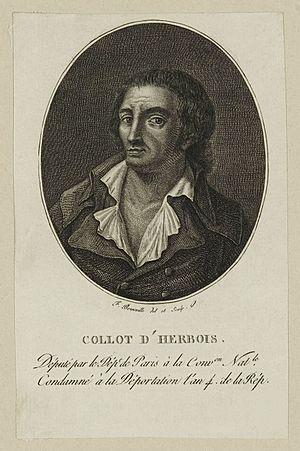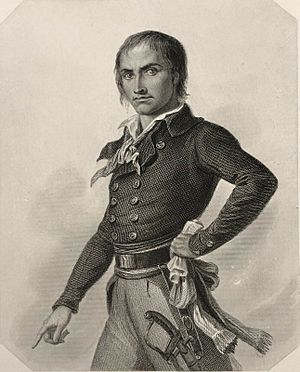Jean-Marie Collot d'Herbois facts for kids
Quick facts for kids
Jean-Marie Collot d'Herbois
|
|
|---|---|
 |
|
| 20th President of the National Convention | |
| In office 19 July 1794 – 3 August 1794 |
|
| Preceded by | Jean-Antoine Louis |
| Succeeded by | Philippe-Antoine Merlin |
| In office 13 June 1793 – 27 June 1793 |
|
| Preceded by | François René Mallarmé |
| Succeeded by | Jacques-Alexis Thuriot |
| Personal details | |
| Born | 19 June 1749 Paris, France |
| Died | 8 June 1796 (aged 46) Cayenne, French Guiana |
| Cause of death | Yellow fever |
| Citizenship | French |
| Political party | the Mountain |
| Parents | Gabriel-Jacques Collot, Jeanne-Agnès Collot née Hannen |
| Occupation |
|
| Known for | member of the Committee of Public Safety, execution of more than 2,000 people in Lyon |
| Signature |  |
Jean-Marie Collot d'Herbois (born June 19, 1749 – died June 8, 1796) was a French actor, writer, and an important figure during the French Revolution. He was a member of the powerful Committee of Public Safety during a period known as the Reign of Terror. While he helped save some people, he was also responsible for many severe actions, especially in the city of Lyon.
Contents
Early Life and Acting Career
Jean-Marie Collot d'Herbois was born in Paris, France. When he was a teenager, he left home to join traveling theater groups. He had a fairly successful career as an actor and also wrote many plays. His work took him all over France, from Bordeaux in the south to Lille in the north. He even traveled to the Dutch Republic, where he met his wife.
In 1784, he became the director of a theater in Geneva, Switzerland. Later, in 1787, he directed a well-known theater in Lyon. When the French Revolution began in 1789, he quickly returned to Paris. His strong voice, writing skills, and ability to organize large public events called fêtes (civic feasts) helped him become famous.
Becoming a Revolutionary Leader
Collot d'Herbois started getting involved in revolutionary activities early on. However, he became truly important in 1791. He published a popular book called L'Almanach du Père Gérard, which supported the idea of a king sharing power with a government. This book made him very well-known.
His fame grew even more when he helped some Swiss soldiers from the Château-Vieux Regiment. These soldiers had been punished for mutiny and sent to work on ships. Collot d'Herbois worked hard to get them freed. A big public celebration was held to honor him and the soldiers.
His political ideas became more and more extreme. Collot d'Herbois was part of the Paris Commune during a major uprising in August 1792. He was then chosen to represent Paris in the National Convention, which was France's new government. On the very first day of the Convention, September 21, 1792, he was the first to demand that the French monarchy be ended. Later, he voted for King Louis XVI to be put to death immediately.
Role in the Reign of Terror
Collot d'Herbois was deeply involved in the power struggles within the National Convention. He sided with a group called the Mountain against another group called the Girondists. After a major political event in May 1793, he strongly attacked the defeated Girondist party. Along with his friend Billaud-Varenne, he was known for his strong views against those who made money from unfair deals. He also suggested ideas for a more equal society. In June, he became president of the National Convention. In September, he joined the Committee of Public Safety, where he acted as a key organizer.
The Convention sent him on several important missions. On October 30, 1793, he was sent to Lyon with Joseph Fouché to deal with a revolt there. In Lyon, he brought in the most severe form of the Reign of Terror. This involved widespread punishments, including many executions. He also began to dismantle parts of the city. His actions were so extreme that the Committee of Public Safety called him back to Paris because they were concerned.
In May 1794, there were attempts to assassinate both Collot d'Herbois and Maximilien Robespierre. Collot d'Herbois was worried he might be arrested and punished himself because of his harsh actions in Lyon. So, he turned against Robespierre during a period known as the Thermidorian Reaction. He even led the Convention during the first session of this change.
Despite this, Collot d'Herbois was later accused of being involved with Robespierre, as they had worked together on the Committee of Public Safety. He was found not guilty the first time. However, he was accused again. He argued that he had only acted for the good of the Revolution. But in March 1795, he was sentenced to be sent to Cayenne, French Guiana, along with Bertrand Barère de Vieuzac and Billaud-Varenne. He died there in 1796 from yellow fever.
His Writings
Collot d'Herbois started his writing career in 1772 with a play called Lucie, ou les Parents imprudents. He continued writing until 1792 with L'Aîné et le cadet. He was a skilled, though not hugely famous, playwright during a busy time for French theater.
Before the Revolution, he wrote at least fifteen plays, with ten of them still existing today. These included Lucie, an adaptation of William Shakespeare's The Merry Wives of Windsor, and an adaptation of Pedro Calderón de la Barca's El Alcalde de Zalamea. These three plays were performed in France for over ten years. During the first three years of the Revolution, he wrote at least seven more plays. Six of these still exist. He combined emotional love stories with political messages in plays like L'Inconnu, ou le Préjugé vaincu and Socrate (about the philosopher Socrates).
In 1791, he wrote the award-winning L'Almanach de père Gérard. This fictional story about revolutionary values became a bestseller and helped establish his political reputation.
He also helped write the first French republican Constitution in 1793, though it was never actually put into practice.
Error: no page names specified (help). In Spanish: Jean-Marie Collot d'Herbois para niños
In Spanish: Jean-Marie Collot d'Herbois para niños


